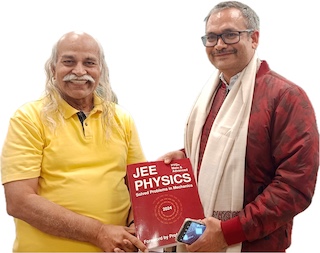Photoelectric Effect
The ejection of electrons from a metal surface when it is illuminated by high energy radiations is called photoelectric effect.
Properties of Radiations
Energy flux S is the rate of transfer of energy through a surface. Let a plane wave is moving in a direction $\hat{k}$ and a surface of area A is placed normal to its direction of motion. The energy flowing through this surface per unit time (i.e., Power P) is given by $P=SA$. Energy flux and intensity are often used interchangeably.
The frequency $\nu$ of radiation is related to its wavelength $\lambda$ by $\nu\lambda=c$, where $c=3\times 10^{8}$ m/s is the speed of light.
The radiation can be viewed as a stream of photons moving with a speed c in the direction $\hat{k}$. The energy of a photon of radiation frequency $\nu$ is given by $E=h\nu,$ where $h=6.63\times{10}^{-34}$ J-s is Planck's constant. A convenient unit of photon's energy is electronvolt (eV). To convert energy from joule to electronvolt, divide it by electron's charge $e=1.6\times{10}^{-19}$ C. It is worth memorizing $hc=1240$ nm-eV which gives $$ E=\frac{hc}{\lambda}=\frac{1240}{\lambda\text{ (in nm)}} \;\text{eV} $$
Photons flux n is the number of photons crossing a unit area in a unit time. It is related to the energy-flux by $n=S/E.$
The linear momentum of a photon of radiation wavelength $\lambda$ is given by $p=h/\lambda.$
Einstein's Equation
In photoelectric effect, a photon of energy $h\nu$ gives its entire energy to an electron. The electron comes out of the metal after doing a work $\phi$ against the binding force of the metal ($\phi$ is called work function). It also loses some energy due to collision with atoms etc. The maximum kinetic energy of the ejected photoelectrons is given by $$ K_\text{max}=h\nu-\phi. $$
The cut-off (or threshold) frequency $\nu_c$ is the frequency at which $K_\text{max}=0$. The radiation of frequency less than $\nu_c$ cannot eject photoelectrons. Its value is given by $$ \nu_c=\phi/h. $$
The stopping potential is the negative potential applied to the collector to stop photocurrent. It is given by $$ V_0=K_\text{max}/e. $$
de Broglie Wavelength
The de~Broglie wavelength of a particle of momentum p is given by $$ \lambda=h/p. $$ If a particle moves with a relativistic speed then its energy E is related to momentum p by $$ E^2={(pc)^2+(mc^2)^2}, $$ where $m$ is the rest mass of the particle and $mc^2$ is its rest mass energy.
Problems from IIT JEE
Problem (IIT JEE 2014): A metal surface is illuminated by light of two different wavelengths 248 nm and 310 nm. The maximum speeds of the photoelectrons corresponding to these wavelengths are $u_1$ and $u_2$, respectively. If the ratio $u_1:u_2=2:1$ and $hc={1240}\;\mathrm{eV\text{-}nm}$, the work function of the metal is nearly
- 3.7 eV
- 3.2 eV
- 2.8 eV
- 2.5 eV
Solution: The maximum kinetic energy of ejected photoelectrons is given by, \begin{align} \label{txb:eqn:1} K_\text{max}=\frac{1}{2}mu^2=\frac{hc}{\lambda}-\phi. \end{align} Substitute the values in above equation to get, \begin{align} \label{txb:eqn:2} &\frac{1}{2}mu_1^2=\frac{1240}{248}-\phi, \\ \label{txb:eqn:3} &\frac{1}{2}mu_2^2=\frac{1240}{310}-\phi. \end{align} Divide above equations and use $u_1/u_2=2$ to get $\phi={3.7}\;\mathrm{eV}$.
